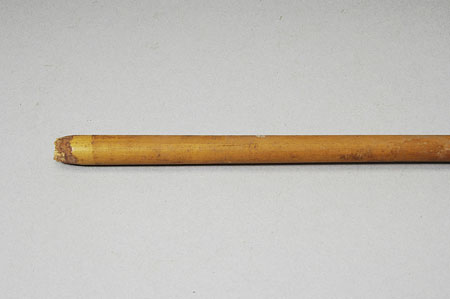Accession Number:
1944.10.71
Country:
Sudan
Region:
Blue Nile ?Darfung
Cultural Group:
?Burun
Date Made:
By 1912
Materials:
Cane Plant , Animal Hide Skin
Process:
Carved , Notched , Bound , Socketed
Dimensions:
L = 779, diam = 9.5 x 9, nock L = 12, binding L = 15 mm [RTS 5/7/2005].
Weight:
19.1 g
Other Owners:
L. Gorringe and Mrs L. Gorringe
Field Collector:
L. Gorringe
PRM Source:
Mrs L. Gorringe
Acquired:
Donated October 1944
Collected Date:
1902 - 1912
Description:
Arrow shaft, cut from a length of orangey brown oval sectioned cane (Pantone 729C), with 5 segments along its length.
The top end has been hollowed out to create a socket, that would normally receive the tang of a wooden arrowhead, in this instance missing.
The sides of this end have also been shaved, and there is a reserve band around the body, showing where a length of binding had formerly been attached.
The lower end of the shaft has its binding still in place, made from a strip of grayish brown hide (Pantone 7531C) with the loose ends tucked underneath to secure them.
Below, the butt has been nocked, with 2 deep rectangular notches cut into opposite sides.
The shaft is complete in itself, but has some slight cracking along the length.
It has a weight of 19.1 grams, a shaft length of 779 mm, diameter of 9.5 by 9 mm, a nock length of 12 mm and lower binding length of 15 mm.
Collected by L. Gorringe at some time between 1902 and 1912, possibly from Darfung, and donated to the Pitt Rivers Museum by his wife, Mrs L. Gorringe.
For a group of bows collected by Gorringe, and possibly from the Burun, see 1944.10.28-34; for additional Burun arrows, see 1944.10.34-71.
Rachael Sparks 29/8/2005.
Collected by L. Gorringe at some time between 1902 and 1912, possibly from Darfung, and donated to the Pitt Rivers Museum by his wife, Mrs L. Gorringe.
For a group of bows collected by Gorringe, and possibly from the Burun, see 1944.10.28-34; for additional Burun arrows, see 1944.10.34-71.
Rachael Sparks 29/8/2005.
Primary Documentation:
Accession Book Entry
[p.
375] -
Mrs L.
GORRINGE, Rosaries Farm, Ngong, Kenya
.
Specimens collected by her late husband, Captain L.
Gorringe, M.C., in the ANGLO-EGYPTIAN SUDAN between 1902 and 1912.
Undocumented.
[p.
383] 1944.10.34-71 - [1 of ] Thirty-eight arrows, all of the same type: cane shafts deeply notched, not feathered, the heads ebony spikes tanged into the shaft and tapering to the point.
Above the notch, which is almost immediately below a joint in the cane, and at the opposite end where the head is inserted, the shafts are bound with a narrow strip of thin membrane.
The ebony heads are round in section and varying in length, the extremes being, from above the shaft binding to the tip, 4 1/4" (with long shaft) and 24 5/8" (with short shaft); all are carved towards the tip end, either with an all-over criss-cross pattern more or less shallowly incised, or with two rows of oblique notches cut alternately on the two sides of the point so as to give it a spiral turn.
In a few specimens the shaft is incised in various patterns (owner’s marks?).
Lengths varying between 3' 6 3/4" and 3' 1".
Same data [Probably the BURUN of DAR FUNG].
(In some specimens the tips of the ebony heads are broken or the shaft bindings loose or missing).
Added Accession Book Entry [p. 382] - A21.F16.17-18 [red biro].
Card Catalogue Entry - There is no further information on the object catalogue cards ['Weapons - offensive - Archery - Arrows' RTS 23/7/2004].
Pitt Rivers Museum label - AFRICA, Sudan. Probably Burun tribe of Darfung. Cane arrow shaft. Don. Mrs L. Gorringe. 1944.10.71 [plastic label, tied to object; RTS 5/7/2005].
Written on object - BURUN, DAR FUNG, A.-E. SUDAN. 1944.10.71 [RTS 5/7/2005].
Added Accession Book Entry [p. 382] - A21.F16.17-18 [red biro].
Card Catalogue Entry - There is no further information on the object catalogue cards ['Weapons - offensive - Archery - Arrows' RTS 23/7/2004].
Pitt Rivers Museum label - AFRICA, Sudan. Probably Burun tribe of Darfung. Cane arrow shaft. Don. Mrs L. Gorringe. 1944.10.71 [plastic label, tied to object; RTS 5/7/2005].
Written on object - BURUN, DAR FUNG, A.-E. SUDAN. 1944.10.71 [RTS 5/7/2005].




